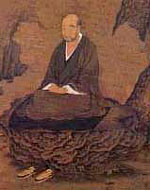Koso Wasan 32
Knowing truly that the Primal Vow -
The perfect One Vehicle that brings about sudden attainment -
Grasps those who commit grave offences and transgressions,
We are quickly brought to realise that blind passions
and enlightenment are not two in substance.
Samsara and Nirvana

The nucleus of this verse refers - in a single phrase - firstly to 'blind passion' (bonno, Sk. klesha - also translated as 'blind passions' (CWS), 'afflicting passions' (Ryukoku, Shozomatsu Wasan), 'defilements' (Bando & Stewart), 'earthly lust' (Amasaki) and even, quite mistakenly - because it is far too limiting - 'sensuous desire'. In a phrase which melds two contrasts, the other word is enlightenment (bodai, Sk. bodhi). 'Blind passion' is a feature of samsara and, of course, enlightenment is a quality of nirvana. This verse recalls for us the principal Mahayana affirmation of the essential 'one-ness' of reality. Shunya ta ('emptiness') is common to all elements of existence, the 'dharmas'. Since even apparently contradictory constituents of the world and the mind are essentially imbued with the same inherence, they are ultimately the same.
Although Shinran Shonin does not expressly refer to samsara and nirvana, he is following T'an-luan and directing our minds to this ultimate one-ness. If it were not for the kleshas ('blind passions') there would be no samsara; if it were not for enlightenment, nirvana could not be realised. Shinran is drawing attention to sudden attainment, which defines the immediacy, the immanence of reality (Sk. tathata) in the world of the senses.
The union of universals that appear to be opposities, especially 'evil passion' and enlightenment - or samsara and nirvana - are brought together in the awakening of many followers of yogic practice; and the Buddha Dharma is the most widespread and succesful yogic tradition, of course. Within the Buddha Dharma the awakening that sees the essential identity of samsara and nirvana is an especially piquant hallmark of tantric Buddhism. In Sahajayoga ('twinning yoga') it is especially emphasised. Yet, it should be remembered that, generally speaking, such realisations are only attained in the context of high levels of spiritual endevour, discipline, strict controls and the guidance of an realised guru.
We need to consider the fact that although T'an-luan mentions the coming together of 'blind passion' and 'enlightenment', the truth is that Pure Land teachers rarely give first-hand expression to such an awareness. T'an-luan is, himself, speaking from the point of view of a highly accomplished and deeply awakened dharma master; but - by contrast - the sixth dharma master in the Jodo Shinshu lineage, Genshin, did not give expression to such an idea. On the contrary: he is famous for his declaration that
Passions obstruct my eyes and I cannot see the light;
Nevertheless, great compassion is unitiring and illuminates
me always1.
And, in any case, even T'an-luan was frank about his spiritual limitations, too.
In the path of sages we have the image of a yogin practicing the disciplined road set forth by the dharma. Presumably, there is a moment in which the yogin sees that nirvana is imbued - impregnated - with samsara. The yogin, as it were, breaks into nirvana. The focus here is of an individual attaining such an awakening on his or her own behalf. This is not what is being expressed when 'blind passions' and enligtenment are described as the same essence in the Pure Land tradition. The picture is reversed.
In the Pure Land tradition, by contrast, it is nirvana that breaks through into samsara. The deeper the sense of one's being bound in samsara, the greater the realisation for the aspirant of the reality Other Power. However, Amida Buddha is the yogin, whose realisation breaks into the heart of the person of shinjin, manifested in Namo Amida Butsu.
1: CWS, p. 73.